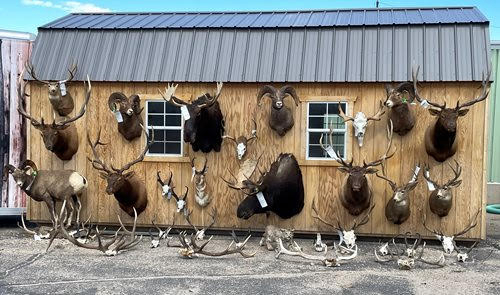Michigan Small Game Outlook
Small game hunting season begins Sept. 1 with the opening of the early Canada goose season and teal seasons and continues until rabbit and hare season ends March 31. Department of Natural Resources wildlife biologists across the state say hunters should find conditions similar to last year. Hunters are reminded that due to changes in licensing, all licensed hunters may pursue small game.
Rabbits
Season: Cottontail rabbits and varying (or snowshoe) hare can be hunted from Sept. 15-March 31  statewide. The daily bag limit is five in combination with a possession limit of 10.
statewide. The daily bag limit is five in combination with a possession limit of 10.
Outlook: Roughly 56,000 hunters reported pursuing rabbits in 2011 (the most recently completed harvest survey) and about 12,000 hunted hares. Cottontail populations are good throughout their range over much of the state. Concentrate on thick cover, such as briar patches and brush piles, often near agricultural fields. Snowshoe hare populations are down from historic levels. Look for early-successional forests (such as aspen stands) and low-lying conifer swamps with blow-downs and brush piles in the northern two-thirds of the state.
Squirrels
Season: Sept. 15-March 1. The daily bag limit is five per day with 10 in possession.
Outlook: Both fox and gray squirrel populations are at moderate to high levels across much of the state. Areas that had good mast production last year are a good bet, as are wood lots adjoining corn fields. Post deer-season hunting, in Jan. and Feb., is increasingly popular. About 72,000 hunters pursue squirrels.
Ruffed Grouse
Season: Sept. 15-Nov. 14 and Dec. 1-Jan. 1, statewide. The bag limit is five per day/10 in possession in the northern two-thirds of the state, three per day/six in possession in Zone 3 (southern Michigan).
 Outlook: Grouse populations are cyclical, typically rising and falling over a 10-year period, and indications are that we are near a bottom, though spring drumming counts during the last two years were up. Hunters are expected to see more birds this year than in 2014. Young to moderate-aged aspen stands – about 6 to 15 years of age – with a thick understory of witch hazel or dogwood are prime grouse habitat. Food sources are important, but wild fruit and berry production should be very good this year due to good spring rains. Grouse are most numerous in the Upper Peninsula and northern Lower Peninsula, but hunters may find local populations in areas with good habitat in southern Michigan as well. Grouse and woodcock hunters are asked to assist the DNR in monitoring populations by reporting their results. Cooperator forms can be found on the DNR web site at www.michigan.gov/hunting (select Upland Game Birds and then Ruffed Grouse). Michigan boasts about 77,000 grouse hunters.
Outlook: Grouse populations are cyclical, typically rising and falling over a 10-year period, and indications are that we are near a bottom, though spring drumming counts during the last two years were up. Hunters are expected to see more birds this year than in 2014. Young to moderate-aged aspen stands – about 6 to 15 years of age – with a thick understory of witch hazel or dogwood are prime grouse habitat. Food sources are important, but wild fruit and berry production should be very good this year due to good spring rains. Grouse are most numerous in the Upper Peninsula and northern Lower Peninsula, but hunters may find local populations in areas with good habitat in southern Michigan as well. Grouse and woodcock hunters are asked to assist the DNR in monitoring populations by reporting their results. Cooperator forms can be found on the DNR web site at www.michigan.gov/hunting (select Upland Game Birds and then Ruffed Grouse). Michigan boasts about 77,000 grouse hunters.
Woodcock
Season: Sept. 19-Nov. 2 statewide. The daily bag limit is three with a possession limit of six.
Outlook: Woodcock populations have been in long-term decline, though there is evidence that decline has slowed in recent years. Hunters can expect about the same results they had last year. Found in all parts of Michigan, woodcock are migratory, and although their population densities are higher in the northern two-thirds of the state, they often can be found in good numbers in southern Michigan later in the season as the birds head south. Some 32,000 hunters say they pursue woodcock in Michigan, the top woodcock-hunting state in the union. All woodcock hunters must obtain a free woodcock stamp in addition to a valid base license; the endorsement stamp is available at all license agents or online at www.mdnr-elicense.com.
Sharp-tailed Grouse
Season: Oct. 10-31 in the eastern Upper Peninsula, east of M-129 and east of I-75 north of M-48. The limit is two daily, with four in possession; six per season.
Outlook: Sharptails use grasslands and associated shrubby habitat; think pheasant habitat. Often found in  small flocks and sometimes difficult to approach, sharptails often require relatively long-range shooting compared to ruffed grouse. Sharptail hunters are required to have a (free) sharp-tailed grouse endorsement on their hunting licenses. In 2013, 350 hunters chased sharptails.
small flocks and sometimes difficult to approach, sharptails often require relatively long-range shooting compared to ruffed grouse. Sharptail hunters are required to have a (free) sharp-tailed grouse endorsement on their hunting licenses. In 2013, 350 hunters chased sharptails.
Pheasants
Season: Oct. 10-31 in the Upper Peninsula in Menominee County and portions of Iron, Marquette, Dickinson and Delta counties, Oct. 20-Nov. 14 in the Lower Peninsula; and Dec. 1-Jan. 1 in selected areas of Zone 3 (southern Michigan). The limit is two cocks daily, with four in possession.
Outlook: Pheasant populations have been in decline for a number of years, primarily because of changes in agricultural practices and/or urban sprawl. Typically, the best habitat is on private lands that have been managed for pheasants, especially those that are enrolled in farm set-aside programs, though some public land is being intensely managed for pheasants. Generally speaking, hunters who enjoyed success last year should find similar hunting conditions in the same areas. The best counties for pheasant hunting occur in south-central to mid-Michigan and into the Thumb, though locally abundant populations can be found almost anywhere. Look for warm-season grasses, especially on idled farm fields. Late-season hunters can have success in cattail and shrub lands adjoining picked agricultural fields. An estimated 23,000 hunters pursue pheasants in Michigan.
Quail
Season: Oct. 20-Nov. 14. Quail can be hunted only in Branch, Calhoun, Clinton, Eaton, Genesee, Gratiot, Hillsdale, Huron, Ingham, Ionia, Jackson, Kent, Lapeer, Lenawee, Livingston, Macomb, Monroe, Montcalm, Oakland, Saginaw, St. Clair, St. Joseph, Sanilac, Shiawassee, Tuscola, Washtenaw and Wayne counties. The bag limit is five per day/10 in possession.
Outlook: Back-to-back harsh winters and ice storms have significantly lowered quail populations. Often associated with pheasant hunting, fewer than 500 hunters reported quail hunting in 2011.
Wild Turkey
Season: Sept. 15-Nov. 14 in eight management units, including the entire Upper Peninsula (except Isle  Royale) and all counties to the south of and including Oceana, Newaygo, Mecosta, Isabella, Midland, Bay and Huron (except Wayne and Monroe). A total of 51,850 licenses are available – 5,150 general licenses that may be used on public or private land and 46,700 licenses for private-land only. Licenses are issued by lottery, though leftover licenses are available over the counter on a first-come, first-served basis until management unit quotas are met. Hunters may take one bird of either sex per license. The limit is one per license.
Royale) and all counties to the south of and including Oceana, Newaygo, Mecosta, Isabella, Midland, Bay and Huron (except Wayne and Monroe). A total of 51,850 licenses are available – 5,150 general licenses that may be used on public or private land and 46,700 licenses for private-land only. Licenses are issued by lottery, though leftover licenses are available over the counter on a first-come, first-served basis until management unit quotas are met. Hunters may take one bird of either sex per license. The limit is one per license.
Outlook: Fall turkey seasons are held only in areas where populations are stable to increasing, so prospects are very good. Roughly 16,000 hunters pursue wild turkeys in the fall hunt, many of them during the archery deer season.
Ducks
Seasons: Early teal (only) season Sept. 1-7. Youth: Sept. 12-13. Regular season: Sept. 26-Nov. 22 and Nov. 28-29 in the North Zone (Upper Peninsula); Oct. 3-Nov. 29 and Dec. 12-13 in the Middle Zone; and Oct.10–Dec. 6 and Dec. 26-27 in the South Zone.
The bag limit for ducks is six per day with no more than four mallards (no more than two hens), three wood ducks, three scaup (bluebills), two redheads, two pintails, two canvasbacks and one black duck. Five additional mergansers (no more than two may be hooded mergansers) may be taken. Possession limit is two days’ daily bag limit.
Outlook: Continent-wide, duck numbers are high, well above the long-term average, with mallard numbers the highest on record. Michigan mallard numbers are similar to last year. Wetland conditions are very good. Hunting should be very good for early season puddle ducks (wood ducks and teal). Diving ducks, which usually begin arriving in good numbers around mid-October, should be plentiful on the Great Lakes, too; notice the extra canvasback allowed this year. About 42,000 hunters pursue ducks in Michigan.
Canada Geese
Seasons: The early season is Sept 1-15 except in the Upper Peninsula and Saginaw, Huron and Tuscola counties, where the season is Sept. 1-10. The daily bag limit is five.
The regular goose seasons are Sept. 11-Dec. 11 in the North Zone; Sept. 19-Dec. 19 in the Middle Zone; and Sept. 19-27, Oct. 10–Dec. 6, and Dec. 26-27 in the South Zone, except in designated goose management units (GMUs). The daily bag limit is two. In the Saginaw County and Tuscola/Huron GMUs, the season is Sept. 19-27, Oct. 10–Dec 6, and Dec. 26–Jan. 19 with a daily bag limit of two. In the Allegan County GMU, the season is Oct. 31-Jan. 30 with a bag limit of two. In the Muskegon Wastewater GMU, the season is Oct. 17-Nov. 14 and Dec. 1-22. The bag limit is two.
the season is Sept. 19-27, Oct. 10–Dec 6, and Dec. 26–Jan. 19 with a daily bag limit of two. In the Allegan County GMU, the season is Oct. 31-Jan. 30 with a bag limit of two. In the Muskegon Wastewater GMU, the season is Oct. 17-Nov. 14 and Dec. 1-22. The bag limit is two.
The late goose season, in the South Zone, excluding the GMUs, is Jan. 23–Feb. 14 with a daily bag limit of five.
Outlook: Resident Canada goose populations, which account for more than 70 percent of the state’s total harvest, are above population goals, so hunters should find plenty of geese. Migratory goose numbers are down somewhat. Except for a few days in Dec. and Jan., waterfowl hunters may pursue geese somewhere in the state from Sept. 1 to Feb 14.
For more information on Michigan hunting, visit www.michigan.gov/hunting.






